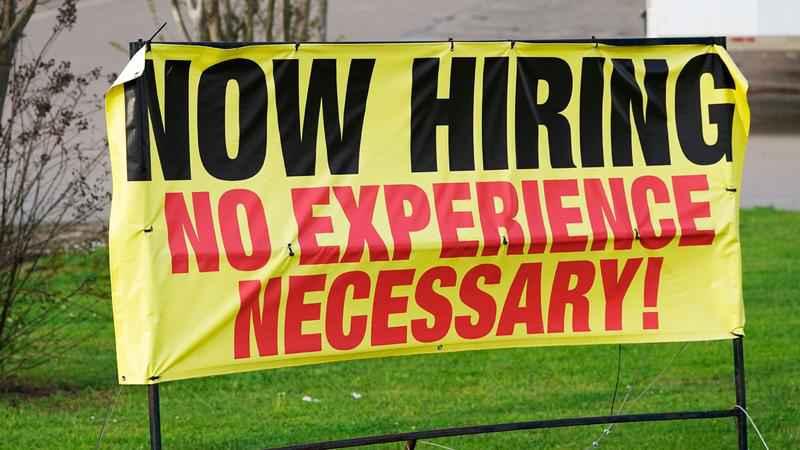DEED reports highest number of job openings in at least 20 years
[anvplayer video=”5069276″ station=”998122″]
A recent Minnesota jobs report showed a record number of openings in the second quarter of 2021, as demand for workers outpaced hiring.
According to the Department of Employment and Economic Development (DEED), there were 205,714 vacancies by the end of June, which was the highest number in at least 20 years. It’s an increase of 84 percent from Q2 of 2020 and an increase of 40 percent compared to the same timeframe in 2019.
This is a really a watershed moment for workforce development in our state,” said Commissioner Steve Grove. “This is a moment where Minnesota has to figure out how it’s going to get more workers, how we’re going to help our businesses grow, and how we’re going to create better jobs for workers such that they’re motivated to take these roles and help grow Minnesota’s economy.”
5 EYEWITNESS NEWS asked Commissioner Grove whether there are enough people to fill the open positions.
“There are enough people if we did a bunch of things we’re not doing right now,” he said. “I think that you want to be able to graduate people from situations where they’re not employed at all into being employable. You want to attract new people into the state. It’s not necessarily a mathematical equation, have enough people to enough jobs, because there’s that kind of friction in the market.”

A roadside banner beckons potential employees outside Channel Control Merchants LLC, an extreme value retailer and exporter of brand sensitive secondary market inventories, in Hattiesburg, Miss., March 27, 2021. With hopes growing for a strong snapback in hiring this year, Friday, April 2 monthly jobs report will provide crucial insight into whether those sunny expectations will come true. The most optimistic economists are predicting the report could show a cool 1 million jobs were added in March.[AP Photo/Rogelio V. Solis]
The report shows the number of vacancies in the second quarter of 2021 was nearly twice that of the unemployed worker population.
“There are certain data points that we have long looked at to determine are we in a healthy economy or not that I almost ignore today,” said Grove. “The unemployment rate, it’s at a record lows 3.7 percent. That’s a great thing. But in the context of what else has happened in the economy, it’s increasingly meaningless because our labor force participation rates are going down. And because there are so many job vacancies in our state.”
The healthcare and social assistance sector has the highest number of job openings at 39, 727. It was closely followed by accommodation and food services at 37,363 and retail trade at 36,174.
“I think the hiring for some of these jobs was kind of on pause during COVID as firms figured things out and now there’s a rush to hire for them,” said Grove. “Part of it is that the economy is now moving faster so with that comes more jobs. And in terms of people’s decision making, I think several folks, they tell us they’re thinking about shifting industries or shifting jobs – that’s hard and that takes time.”
He said other workers are reluctant to return to work due to concerns over the delta variant, while some may face challenges finding child care.
“We have to fix a broken marketplace for childcare in Minnesota,” said Grove. “[Another factor] is housing. As people think about moving from one town to another or taking a job in Minnesota from out of state, if there’s not a housing stock there, they can’t move in, in particular, in more rural parts of our state and greater Minnesota housing is a huge challenge.”
This latest job vacancy report reflects the second quarter, which ended on June 30. During that time, the vaccine rollout was still in relatively early stages, not all kids had returned to the classroom and there were still extra unemployment checks going out.
The Pandemic Unemployment Assistance payments stopped in early September. About two dozen states opted out of the additional $300 checks before the deadline, arguing it was affecting businesses’ ability to hire employees.
Grove argued that wasn’t a factor in Minnesota.
J.P. Morgan Chase Institute, Columbia University researchers and the Federal Reserve Bank of San Francisco have all analyzed whether the additional $300 and $600 unemployment benefits affected job-seekers reentering the workforce. While each report differed, overall the economists all found that while the checks did have an impact, it was a relatively small.
According to Grove, the economy was on this path before COVID hit.
“Even before the pandemic 70 percent of businesses in Minnesota were indicating they had workforce shortages,” he said. “You’ve got kind of the triple whammy of massive demographic shifts that were already going to be a challenge for Minnesota, an economy that has long had, I think, pretty big disparities between workers and businesses, and then a pandemic that just accelerated and amplified all these existing trends.”
The state has created a website dedicated to recruiting workers to the state. In addition, Grove said DEED has been reaching out by phone potential job-seekers.
“This is an urgent crisis,” said Grove. “We’re just saying there’s opportunity out there. We’re trying to help match people to jobs. We’re here to help.”
The Governor’s Council on Economic Expansion was convened over the summer. A committee of 15 CEOs, community leaders and union representatives are collaborating to create strategies to address the problem. Their report is expected to be presented to Governor Walz later this month.